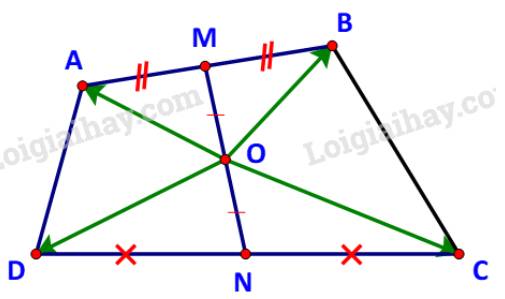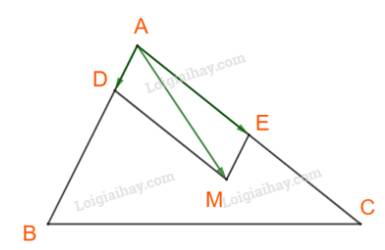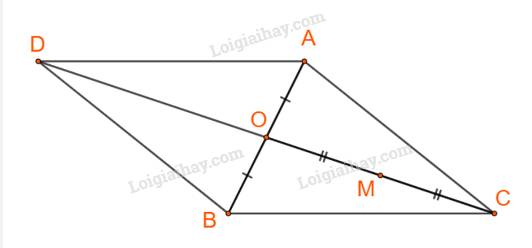Gọi O là tâm của tam giác đều ABC. Chứng minh rằng : \(\overrightarrow{OA}+\overrightarrow{OB}+\overrightarrow{OC}=\overrightarrow{0}\) ?
Cho tam giác ABC nội tiếp trong đường tròn tâm O. Gọi G và H theo thứ tự là trọng tâm và trực tâm của tam giác. Chứng minh rằng
\(\overrightarrow{OA}+\overrightarrow{OB}+\overrightarrow{OC}=\overrightarrow{OH}\)
Từ đó chứng minh G,H, O thẳng hàng.
Đặt \(\overrightarrow{u}=\overrightarrow{OA}+\overrightarrow{OB}+\overrightarrow{OC}-\overrightarrow{OH}\)
Ta sẽ chứng minh \(\overrightarrow{u}=\overrightarrow{O}\)
Gọi A1, B1, C1 theo thứ tự là hình chiếu của A, B, C ( cũng là hình chiếu của H) trên các đường thẳng BC, CA, AB và gọi Ao, Bo, Co theo thứ tự là trung điểm BC, CA, AB (như hình vẽ)
Chiếu vectơ \(\overrightarrow{u}\) lên đường thẳng BC theo phương của \(\overrightarrow{AH}\) ta được
\(\overrightarrow{u_a}=\overrightarrow{A_oA_1}+\overrightarrow{A_oB}+\overrightarrow{A_oC}-\overrightarrow{A_oA_1}=\overrightarrow{O}\)
Suy ra \(\overrightarrow{u}\) cùng phương với \(\overrightarrow{AH}\) (1)
Tương tự như vậy,
ta cũng có \(\overrightarrow{u}\) cùng phương với \(\overrightarrow{BH,}\overrightarrow{CH}\) (2)
Từ (1) và (2) và do các vectơ \(\overrightarrow{AH,}\), \(\overrightarrow{BH},\overrightarrow{CH}\) đôi một không cùng phương suy ra \(\overrightarrow{u}=\overrightarrow{O}\)
Vậy \(\overrightarrow{OA}+\overrightarrow{OB}+\overrightarrow{OC}=\overrightarrow{OH}\)
Nhưng \(\overrightarrow{OA}+\overrightarrow{OB}+\overrightarrow{OC}=3\overrightarrow{OG}\) nên \(\overrightarrow{OH}=3\overrightarrow{OG}\)
Do đó G, H, O thẳng hàng
câu 1: cho tứ giác ABCD. Gọi O là trung điểm của AB.
Chứng minh rằng: \(\overrightarrow{OD}+\overrightarrow{OC}=\overrightarrow{AD}+\overrightarrow{BC}\)
Câu 2: Cho tam giác ABC. Gọi A' là điểm đối xứng của B qua A, B' là điểm dối xứng của C qua B, C' là điểm đối xứng của A qua C. Với một điểm O bất kì, chứng minh rằng:
\(\overrightarrow{OA}+\overrightarrow{OB}+\overrightarrow{OC}=\overrightarrow{OA'}+\overrightarrow{OB'}+\overrightarrow{OC'}\)
câu 2 ( các kí hiệu vecto khi lm bài thỳ b tự viết nhé mk k viết kí hiệu để trả lời cho nhanh hỳ hỳ )
OA+ OB + OC = OA'+ OB' + OC'
<=> OA - OA' + OB - OB' + OC - OC' = 0
<=> A'A + B'B + C'C = 0
<=> 2 ( BA + CB + AC ) = 0
<=> 2 ( CB + BA + AC ) = 0
<=> 2 ( CA + AC ) = 0
<=> 0 = 0 ( luôn đúng )
câu 1 ( các kí hiệu vecto b cx tự viết nhá )
VT = OD + OC = OA + AD + OB + BC = OA + OB + AD + BC = BO + OB + AD + BC = 0 + AD + BC = AD + BC = VP ( đpcm)
Cho tam giác ABC có trọng tâm G. Chứng minh rằng với điểm O tùy ý, ta có
\(\overrightarrow {OB} + \overrightarrow {OA} + \overrightarrow {OC} = 3\overrightarrow {OG} \).
Ta có: \(\overrightarrow {OA} = \overrightarrow {OG} + \overrightarrow {GA} \); \(\overrightarrow {OB} = \overrightarrow {OG} + \overrightarrow {GB} \); \(\overrightarrow {OC} = \overrightarrow {OG} + \overrightarrow {GC} \)
\(\begin{array}{l} \Rightarrow \overrightarrow {OB} + \overrightarrow {OA} + \overrightarrow {OC} = \overrightarrow {OG} + \overrightarrow {GA} + \overrightarrow {OG} + \overrightarrow {GB} + \overrightarrow {OG} + \overrightarrow {GC} \\ \Leftrightarrow \overrightarrow {OB} + \overrightarrow {OA} + \overrightarrow {OC} = 3\overrightarrow {OG} + \left( {\overrightarrow {GA} + \overrightarrow {GB} + \overrightarrow {GC} } \right)\end{array}\)
Do G là trọng tâm của tam giác ABC nên \(\overrightarrow {GB} + \overrightarrow {GA} + \overrightarrow {GC} = \overrightarrow 0 \)
\(\begin{array}{l} \Rightarrow \overrightarrow {OB} + \overrightarrow {OA} + \overrightarrow {OC} = 3\overrightarrow {OG} + \overrightarrow 0 \\ \Leftrightarrow \overrightarrow {OB} + \overrightarrow {OA} + \overrightarrow {OC} = 3\overrightarrow {OG} \end{array}\)
cho hbh abcd tâm O. Chứng minh rằng:
\(\overrightarrow{OA}\) + \(\overrightarrow{OB}\)+ \(\overrightarrow{OC}\) + \(\overrightarrow{OD}\)= \(\overrightarrow{0}\)
1. Cho tam giác ABC có O là điểm thỏa mãn \(\overrightarrow{OA}+\overrightarrow{OB}+\overrightarrow{OC}=\overrightarrow{0}\) và OA=OB=OC. Gọi M ,N ll là trung điểm của BC,AC . Tính số đo của \(\left(\overrightarrow{AM,}\overrightarrow{BN}\right)\)
2. Cho hình vuông ABCD có độ dài bằng cạnh a . Gọi P,Q ll là trung điểm của CD,DA . Tính \(\overrightarrow{BQ}.\overrightarrow{BP}\)
Help me ! Tks
1.
Gọi G là trọng tâm tam giác
\(\overrightarrow{OA}+\overrightarrow{OB}+\overrightarrow{OC}=\overrightarrow{0}\)
\(\Leftrightarrow3\overrightarrow{OG}=\overrightarrow{0}\)
\(\Leftrightarrow O\equiv G\)
\(\Rightarrow O\) là trọng tâm tam giác ABC
\(\Rightarrow\Delta ABC\) đều
Gọi độ dài các cạnh tam giác là a
\(\overrightarrow{BN}.\overrightarrow{AM}=\dfrac{1}{4}\left(\overrightarrow{AB}+\overrightarrow{AC}\right)\left(\overrightarrow{BA}+\overrightarrow{BC}\right)=-\dfrac{1}{4}a^2-\dfrac{1}{8}a^2-\dfrac{1}{8}a^2+\dfrac{1}{2}a^2=0\)
Mặt khác \(\overrightarrow{BN}.\overrightarrow{AM}=BN.AM.cos\left(\overrightarrow{AM};\overrightarrow{BN}\right)\)
\(\Rightarrow BN.AM.cos\left(\overrightarrow{AM};\overrightarrow{BN}\right)=0\Rightarrow cos\left(\overrightarrow{AM};\overrightarrow{BN}\right)=0\Rightarrow\left(\overrightarrow{AM};\overrightarrow{BN}\right)=90^o\)
\(BD=\dfrac{AB}{cos45^o}=\dfrac{a}{\dfrac{\sqrt{2}}{2}}=a\sqrt{2}\)
\(\overrightarrow{BQ}.\overrightarrow{BP}=\dfrac{1}{4}\left(\overrightarrow{BA}+\overrightarrow{BD}\right)\left(\overrightarrow{BC}+\overrightarrow{BD}\right)\)
\(=\dfrac{1}{4}BA.BC.cos90^o+\dfrac{1}{4}BA.BD.cos45^o+\dfrac{1}{4}BD.BC.cos45^o+\dfrac{1}{4}BD^2\)
\(=\dfrac{1}{4}a^2+\dfrac{1}{4}a^2+\dfrac{1}{2}a^2=a^2\)
Cho tứ giác ABCD. Gọi M, N lần lượt là trung điểm của các cạnh AB, CD và O là trung điểm của MN. Chứng minh rằng: \(\overrightarrow {OA} + \overrightarrow {OB} + \overrightarrow {OC} + \overrightarrow {OD} = \overrightarrow 0 .\)
Tham khảo:

Dễ thấy: \(\overrightarrow {OA} = \overrightarrow {OM} + \overrightarrow {MA} \); \(\overrightarrow {OB} = \overrightarrow {OM} + \overrightarrow {MB} \)
Tương tự: \(\overrightarrow {OC} = \overrightarrow {ON} + \overrightarrow {NC} \); \(\overrightarrow {OD} = \overrightarrow {ON} + \overrightarrow {ND} \)
\(\begin{array}{l} \Rightarrow \overrightarrow {OA} + \overrightarrow {OB} + \overrightarrow {OC} + \overrightarrow {OD} = \left( {\overrightarrow {OM} + \overrightarrow {MA} } \right) + \left( {\overrightarrow {OM} + \overrightarrow {MB} } \right) + \left( {\overrightarrow {ON} + \overrightarrow {NC} } \right) + \left( {\overrightarrow {ON} + \overrightarrow {ND} } \right)\\ = \left( {\overrightarrow {OM} + \overrightarrow {OM} + \overrightarrow {MA} + \overrightarrow {MB} } \right) + \left( {\overrightarrow {ON} + \overrightarrow {ON} + \overrightarrow {NC} + \overrightarrow {ND} } \right)\\ = \overrightarrow {OM} + \overrightarrow {OM} + \overrightarrow {ON} + \overrightarrow {ON} \\ = \left( {\overrightarrow {OM} + \overrightarrow {ON} } \right) + \left( {\overrightarrow {OM} + \overrightarrow {ON} } \right)\\ = \overrightarrow 0 + \overrightarrow 0 \\ = \overrightarrow 0 .\end{array}\)
Gọi \(AM\) là trung tuyến của tam giác ABC và D là trung điểm của đoạn AM. Chứng minh rằng :
a) \(2\overrightarrow{DA}+\overrightarrow{DB}+\overrightarrow{DC}=\overrightarrow{0}\)
b) \(2\overrightarrow{OA}+\overrightarrow{OB}+\overrightarrow{OC}=4\overrightarrow{OD}\) , với O là điểm tùy ý
a) Gọi M là trung điểm của BC nên:
Ta có:

vì 
Mặt khác, do D là trung điểm của đoạn AM nên 
Khi đó: 
b) Ta có:

 luôn đúng theo câu a
luôn đúng theo câu a
Vậy: , với O là điểm tùy ý
, với O là điểm tùy ý
Cho tam giác ABC
a) Hãy xác định điểm M để \(\overrightarrow {MA} + \overrightarrow {MB} + 2\overrightarrow {MC} = \overrightarrow 0 \)
b) Chứng minh rằng với mọi điểm O, ta có \(\overrightarrow {OA} + \overrightarrow {OB} + 2\overrightarrow {OC} = 4\overrightarrow {OM} \)
Tham khảo:
a) Ta có: \(\overrightarrow {MA} + \overrightarrow {MB} + 2\overrightarrow {MC} = \overrightarrow 0 \Leftrightarrow \overrightarrow {MA} + \left( {\overrightarrow {MA} + \overrightarrow {AB} } \right) + 2\left( {\overrightarrow {MA} + \overrightarrow {AC} } \right) = \overrightarrow 0 \)
\(\begin{array}{l} \Leftrightarrow 4\overrightarrow {MA} + \overrightarrow {AB} + 2\overrightarrow {AC} = \overrightarrow 0 \\ \Leftrightarrow 4\overrightarrow {AM} = \overrightarrow {AB} + 2\overrightarrow {AC} \\ \Leftrightarrow \overrightarrow {AM} = \frac{1}{4}\overrightarrow {AB} + \frac{1}{2}\overrightarrow {AC} \end{array}\)
Trên cạnh AB, AC lấy điểm D, E sao cho \(AD = \frac{1}{4}AB;\;\,AE = \frac{1}{2}AC\)

Khi đó \(\overrightarrow {AM} = \overrightarrow {AD} + \overrightarrow {AE} \) hay M là đỉnh thứ tư của hình bình hành AEMD.
b) Chứng minh rằng với mọi điểm O, ta có \(\overrightarrow {OA} + \overrightarrow {OB} + 2\overrightarrow {OC} = 4\overrightarrow {OM} \)
Với mọi điểm O, ta có: \(\left\{ \begin{array}{l}\overrightarrow {OA} = \overrightarrow {OM} + \overrightarrow {MA} ;\;\\\overrightarrow {OB} = \overrightarrow {OM} + \overrightarrow {MB} ;\;\,\\\overrightarrow {OC} = \overrightarrow {OM} + \overrightarrow {MC} \end{array} \right.\)
\(\begin{array}{l} \Rightarrow \overrightarrow {OA} + \overrightarrow {OB} + 2\overrightarrow {OC} = \left( {\overrightarrow {OM} + \overrightarrow {MA} } \right) + \left( {\overrightarrow {OM} + \overrightarrow {MB} } \right) + 2\left( {\overrightarrow {OM} + \overrightarrow {MC} } \right)\\ = 4\overrightarrow {OM} + \left( {\overrightarrow {MA} + \overrightarrow {MB} + 2\overrightarrow {MC} } \right) = 4\overrightarrow {OM} + \overrightarrow 0 = 4\overrightarrow {OM} .\end{array}\)
Vậy với mọi điểm O, ta có \(\overrightarrow {OA} + \overrightarrow {OB} + 2\overrightarrow {OC} = 4\overrightarrow {OM} \).
Tham khảo cách 2 câu a:
Cách 2:
Ta có: \(\overrightarrow {MA} + \overrightarrow {MB} + 2\overrightarrow {MC} = \overrightarrow 0 \Leftrightarrow \left( {\overrightarrow {MC} + \overrightarrow {CA} } \right) + \left( {\overrightarrow {MC} + \overrightarrow {CB} } \right) + 2\overrightarrow {MC} = \overrightarrow 0 \)
\(\begin{array}{l} \Leftrightarrow 4\overrightarrow {MC} + \overrightarrow {CA} + \overrightarrow {CB} = \overrightarrow 0 \\ \Leftrightarrow 4.\overrightarrow {CM} = \overrightarrow {CA} + \overrightarrow {CB} \end{array}\)
Gọi D là đỉnh thứ tư của hình bình hành ACBD.
Khi đó: \(\overrightarrow {CD} = \overrightarrow {CA} + \overrightarrow {CB} \)\( \Rightarrow 4.\overrightarrow {CM} = \overrightarrow {CD} \)
\( \Leftrightarrow \overrightarrow {CM} = \frac{1}{4}\overrightarrow {CD} \Leftrightarrow \overrightarrow {CM} = \frac{1}{2}\overrightarrow {CO} \)
Với O là tâm hình bình hành ACBD, cũng là trung điểm đoạn AB.

Vậy M là trung điểm của trung tuyến kẻ từ C của tam giác ABC.
Cho tam giác ABC nội tiếp trong đường tròn tâm O, H là trực tâm của tam giác. D là điểm đối xứng của A qua O
a) Chứng minh tứ giác HCDB là hình bình hành
b) Chứng minh :
\(\overrightarrow{HA}+\overrightarrow{HD}=2\overrightarrow{HO}\)
\(\overrightarrow{HA}+\overrightarrow{HB}+\overrightarrow{HC}=2\overrightarrow{HO}\)
\(\overrightarrow{OA}+\overrightarrow{OB}+\overrightarrow{OC}=\overrightarrow{OH}\)
c) Gọi G là trọng tâm tam giác ABC
Chứng minh \(\overrightarrow{OH}=3\overrightarrow{OG}\). Từ đó kết luận gì về 3 điểm O, H, G ?
Có \(BH\perp AC\). (1)
\(\widehat{ADC}=90^o\) (góc nội tiếp chắn nửa đường tròn) vì vậy\(AC\perp DC\). (2)
Từ (1) và (2) suy ra BH//DC. (3)
Tương tự HC//BD (vì cùng vuông góc với AB). (4)
Từ (3);(4) suy ra tứ giác HCDB là hình bình hành.
b) Do O là trung điểm của AD nên \(\overrightarrow{HA}+\overrightarrow{HD}=2\overrightarrow{HO}\).
Do M là trung điểm của BC nên \(\overrightarrow{HB}+\overrightarrow{HC}=2\overrightarrow{HM}=\overrightarrow{HD}\).
Vì vậy \(\overrightarrow{HA}+\overrightarrow{HB}+\overrightarrow{HC}=\overrightarrow{HA}+\overrightarrow{HD}=2\overrightarrow{HO}\).
\(\overrightarrow{OA}+\overrightarrow{OB}+\overrightarrow{OC}=3\overrightarrow{OH}+\overrightarrow{HA}+\overrightarrow{HB}+\overrightarrow{HC}\)
\(=3\overrightarrow{HO}+2\overrightarrow{HO}=2\left(\overrightarrow{HO}+\overrightarrow{OH}\right)+\overrightarrow{HO}\)
\(=2.\overrightarrow{0}+\overrightarrow{HO}=\overrightarrow{HO}\).
c) Ta có:
\(\overrightarrow{OA}+\overrightarrow{OB}+\overrightarrow{OC}=3\overrightarrow{OG}+\overrightarrow{GA}+\overrightarrow{GB}+\overrightarrow{GC}\)\(=3\overrightarrow{OG}\) (theo tính chất trọng tâm tam giác). (5)
Mặt khác theo câu b)
\(\overrightarrow{OA}+\overrightarrow{OB}+\overrightarrow{OC}=\overrightarrow{OH}\). (6)
Theo (5) và (6) ta có: \(\overrightarrow{OH}=3\overrightarrow{OG}\).
Suy ra ba điểm O, H, G thẳng hàng ( đường thẳng Ơ-le).